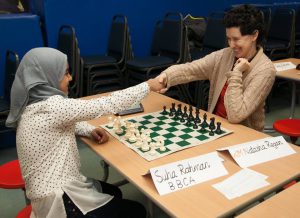November and December have been crazy months, primarily from a work point of view but also from a chess point of view. On the 4th December I took part in the first Rapid Chess Tournament organised by the British Bangla Chess Association (http://britishbanglachess.com/4th-december-2016/)



It was a fun day though the chess ended in disappointment as I blundered into mate in 2 from a strong position as time ran short. All credit to my resourceful and very friendly opponent of course! As befits my custom, a loss is followed by enforced analysis of the game. I’ve always believed that the prospect of spending hours looking at the ruins of my position should act as a motivation to avoid defeat! One particular episode in the game was very interesting and I’d like to share it with you. The game is available again in playable form at http://cloudserver.chessbase.com/MTIyMTYx/replay.html
Bukojemski,Adam – Sadler,Matthew D
Bangla Chess Rapid 2016
The opening phase had gone well for me and multiple threats during the middlegame had led to the win of the h pawn. White had managed to drum up some counterplay in return but I was convinced that Black should be able to repel White’s attack with some accurate moves. Finding the correct sequence in a rapid game is not easy however. I invested my significant time advantage of a couple of minutes into this position but didn’t get any further than the mess I’d seen within the first 20 seconds of my thinking time. It’s an interesting moment and I’ll spend some time discussing this later.
27…gxf6
27…Bxf4 28.Rxf4 Qc7
was my first thought, attacking the vulnerable e5 pawn and activating my queen along my primary route of counterplay: the c-file. I was worried by
29.Qg3
29.Qxd4 Rd8.
After 29…g5
I was looking at lines like 30.Rg4 Kh7 when both 31.Rxg5 and 31.Rh4 looked scary. All of a sudden I wasn’t sure how quickly my own play was arriving! The move 30.Rh4 also led to slight panic.
It turns out that neither of these lines is dangerous for Black:
a) 30.Rg4 Kf8
This concept of running the king away from the kingside only occurred to me later in the game once it was forced onto me. The threat of …Rc1+ and …Qxe5 keeps White’s queen tied down to the defence of the e5 pawn which makes it virtually impossible for him to create rapid play against the Black king.
31.Rd3 Rd8 32.Kh2 Ke8
Black’s king is safe and White’s pieces are bound hand and foot.
b) 30.Rh4 Rc1+
30…Re2 is the other way 31.Rxh6 (31.Rc3 dxc3 32.Rxh6 Qa7+ 33.Kh2 Qe3) 31…Qc1+ The same idea as the main line: cover the g5 pawn with the queen from an attacking position 32.Kh2 Rcc2
31.Kh2 Rf1
32.Rxh6
32.Rc3 Qxc3 (32…dxc3 33.Rxh6 leads to a draw by repetition 33…Rxf6 34.Rxf6 c2 35.Qxg5+ Kf8 36.Rh6 Ke8 37.Rh8+ Kd7 38.Qd2+ Ke7 39.Qg5+) 33.bxc3 Rxc3 34.Qg4 Rf4 wins!
32…Qc1
The key idea! Get the queen to c1 to cover Black’s kingside remaining pawn cover)
Was it possible to find all these variations during the game in a few minutes of feverish thought? No, but that wasn’t what was necessary. The key general concept to come up with was to run the king away from the kingside. Once you understand that 27…Bxf4 28.Rxf4 Qc7 29.Qg3 g5 30.Rg4 Kf8 is the start of a good long-term plan for Black, that gives you confidence to look deeper into lines such as 30.Rh4 and dare to consider counterplay (30…Rc1+ & …Rf1 or 30…Re2) rather than just passive defence.
My problem was that I dived straightaway into calculating variations after 27…gxf6 and never had the calm to step back and reason what I wanted to do in the position. I felt almost immediately that I was focusing on a course of action – opening the kingside – that would inevitably give White decent chances but once I started looking at variations, I couldn’t switch course and just kept on going. My world narrowed itself to the thought of destroying the threat immediately under my nose – the f6 pawn – and nothing else could force its way into my head. For that reason, I was blind to any possibilities of running my king away from danger or hitting back at White with counterplay using my control of the c-file. Understanding the right time to dive into details is a key practical skill which I got wrong in this game. I couldn’t maintain my overview of the position at this moment and I’m convinced that my vulnerability in the rest of the game – which eventually led to a blunder – came from this moment.
Back to the game now after 27…gxf6
28.exf6
Not a bad move at all, but a slight relief as the focus of my feverish calculations had been the dangerous
28.Qh3
keeping all White’s options in reserve. White’s first threat is 29.exf6 Qxf6 30.Bxg5 as 30…Qxg5 31.Rg3 wins the queen. Black has 3 logical choices:
- To keep on destroying White’s kingside pawn roller with 28…fxe5
- To run with the king with 28…Kf8
- To look for counterplay.
a) 28..fxe5 29.Bxg5 hxg5 30.Qh5
The nightmare scenario for Black: plenty of material but facing an overwhelming attacking force with an open king.
30…R2c7
The only way to defend f7, but this releases the last remaining pressure that Black was exerting on White’s position (attack on g2). White is completely free now to attack Black’s king. (30…R8c7 31.Rh3 Kf8 32.Qh8+ Ke7 33.Rxf7+ wins; 30…Qf8 31.Rh3 Qg7 32.Rxf7 wins)
31.Rbf3 Qf8
31…f6 32.Rxf6
32.Qxg5+ Qg7 33.Qh4 wins
b) 28…Kf8
We saw how effective fleeing with the king was in the variation 27…Bxf4 28.Rxf4 Qc7 29.Qg3 g5 30.Rg4 Kf8. Here the attempt is less effective as 27…gxf6 has opened lines which the White rooks can use.
29.Bxg5 hxg5 30.Rbf3
is very powerful
30…Rc1 31.Qh8+ Ke7 32.Qxf6+ Kd7
and now the very fine move
33.Qg7 Rxf1+ 34.Rxf1 Kc6 35.Rxf7
is very difficult for Black as 35…Rc7 36.Rxc7+ Qxc7 37.Qxc7+ Kxc7 38.Kf2 is a winning ending for White;
c) 28…Rc1
A Stockfish idea! It’s a stunner – I wish I’d thought of it. Black reasons that White has virtually destroyed his own position in his efforts to drum up some counterplay. The advance of White’s h- and f-pawns (and the sacrifice of a couple of pawns) has left many weak dark-squares (such as e3) in the heart of White’s position. A bishop on a powerful central dark-square might easily provide more than sufficient compensation for the exchange. The reason it doesn’t manage to give Black the advantage lies in the weakness of Black’s king. White has enough open lines (f- and g-file) against the Black king to keep Black’s queen and bishop a little tied down. It is a wonderful idea though!
29.Rxc1 Rxc1+ 30.Bxc1 Bxc1 31.Qg3+ Bg5 32.exf6 Qxf6 33.Qb8+ Kg7 34.Rf3 Qg6 35.Qc7
which Komodo considers about equal. White’s pressure against f7 stops Black’s queen from doing too much damage!
d) 28…d3
My favourite way of playing this position. Unfortunately, Black is the one fighting to hold the balance.
29.Rxd3 Qb6+ 30.Kh2 Rf2
The key resource which I hoped might give Black the advantage. However as I realised during my home analysis, the tactics are on White’s side for the moment
31.Bxg5
A key intermezzo
31…hxg5
31…Rxf1 32.Be3 Qb8 33.Bxh6 Qxe5+ 34.Rg3+ wins; 31…fxg5 32.Qxh6 Amazingly enough, no draw for Black 32…Rxf1 33.Qxg5+ Kf8 34.Qh6+ Ke7 35.Qh4+ Ke8 36.Qh8+ Ke7 37.Qxc8 Qg1+ 38.Kh3 Rf3+ So far my line. I chose 39.gxf3 which is +11.57. There is even better 39.Rxf3 Qh1+ 40.Kg3 Qe1+ 41.Kh2 Qh4+ 42.Rh3 Qf4+ 43.Kg1
32.Rd6 Qa7
32…Qxd6 33.exd6 Rxf1 34.d7 Rd8 35.Qd3 Rf4 36.Qd6 Rxe4 37.Qe7 Rxd7 38.Qxd7 Rxb4 I’m assuming Black should draw this fairly easily, but it’s not a winning attempt
33.Rfd1
Very dangerous for Black, but holdable! There are a couple of alternatives:
a) 33.Rxa6
A clever idea, but it allows Black to coordinate his forces again
33…Qd4 34.Rxf2 Qxf2 35.exf6 Qxf6
Equal pawns but this felt more difficult for White. Komodo gives –1.44, and -2.78 after the even more accurate 35…Qf4+!;
b) 33.Rc1
I got very excited about this idea. Komodo says he found many ways to neutralise it, but the positions remain complicated
33…Qa8 34.Rc5 Kg7
34…Rf4 Komodo 35.Qd3 Kh7 36.g3 Rf2+ 37.Kg1 Rxb2 38.Qf3 Rxc5 39.bxc5 Rb1+ 40.Kf2 Qg8 is apparently equal but looks fraught for Black to me!
35.exf6+ Kg6
was the idea that got me excited, looking for …Rh8 but
36.Rxg5+ Kxg5 37.Qg3+ Kh5 38.Qh3+
is just a draw (38.Qxf2 Qxe4)
After 33.Rfd1, Black must be very careful:
a) 33…Kg7
is very tempting looking to exploit the White king and queen on the h-file but…
34.Rd7 Qb8
34…Rc7 35.Rd8
35.Rxf7+
35…Kxf7 36.Rd7+ wins;
b) 33…Re8
My first thought to cover against the threat of Rd8+ and Rxe6, but it’s not the best
34.Rd8 Qe7 35.Rxe8+ Qxe8 36.Qe3
36…Rxb2
36…Rf4 37.g3 Rg4 38.exf6 and the rook on g4 is trapped! 38…Qc6 39.Re1 e5 40.Qe2 Qe6 41.Rf1 followed by Rf5
37.exf6 Qb8+ 38.e5;
c) 33…Qe7 34.Rd7 Qf8 35.Kg1 Rf4 36.g3 Rxe4 37.exf6 wins;
d) 33…Qc7 34.Qh6
34.Rd7 Qb8 is not so clear (34…Qxe5+ 35.Kg1 wins)
34…Rf4 35.Kg3
Finally! I was looking for this idea continually! White plans Rh1!
35…Qe7 36.Rh1 Rh4 37.Rxh4 gxh4+ 38.Qxh4
is good for White;
e) 33…Rf4 34.Rd8+ Kg7
I’d assumed this was winning. It’s not that clear! 34…Rxd8 35.Rxd8+ Kg7 36.Qh8+ Kg6 37.Rg8#
35.exf6+
35.Qh8+ Kg6 36.Qg8+ Kh6 37.Qh8+ Kg6 is a draw
35…Kg6
35…Kxf6 36.Qh6+
36.Rxc8 Rh4 37.Rg8+ Kh7
37…Kxf6 38.e5+ Ke7 39.Qxh4 gxh4 40.Rdd8
38.Rg7+ Kh6 39.Qxh4+ gxh4 40.Rf1
is better for White according to Komodo, though Komodo finds a way to keep things afloat;
f) 33…Rf8
was the move I settled on in the end and seems indeed to be the safest.
34.Rd7
34.Rd8 Qe7 35.Rxf8+ Qxf8 The queen is much better placed on f8 than on e8
34…Qb8 35.Kg1
35.R1d6 Rf4
35…Rxb2 36.Qh6 Qxe5 37.Rd8 Rxg2+ 38.Kxg2 Qxe4+
is a draw by repetition.
Back to the game now, gradually edging closer to the moment where I have to avert my eyes…
28…Qxf6 29.Bxg5
29.Bc7 Be3+
29…Qxg5 30.Qh3
Black’s plan of running with the king is virtually forced, but it’s also what he wants to do!
30…Kf8 31.Rg3
31.Rbf3
was an idea I had at home, but it only works if Black defends passively.
31…Ke7
31…R8c7 32.Rg3 Qe5 33.Qxh6+ Ke7 34.Rxf7+ Kd6 35.Qf8+ The difference and the point of my idea: the 8th rank is no longer covered!
32.Rxf7+ Kd6
looked good for Black to me due to the threat of …Qe3+ and Komodo concurs. Once again an example of how important the idea of running with the king was in this phase of the game!
33.Re1 Rc1
31…Qe5 32.Qxh6+
A serious mistake. It allows Black’s king to get safe while White’s rooks are poorly coordinated. There were a couple of alternatives
a) 32.Rg6
Ingenious but not strong
32…Ke7 33.Rgf6 Rg8 34.Rxf7+ Kd6
b) 32.Rgf3
Best
32…R2c7
is safest but as explained before, it does release Black’s pressure against White’s king (the g2 square)
32…R8c7 33.Qxh6+ Qg7 34.Qh2 looked awkward to me. Komodo assesses the position as equal 34…Rc1 35.Qd6+ Ke8 36.Rxc1 Rxc1+ 37.Kh2 Rc2 38.Rg3 Qh6+ 39.Rh3 Qg7 40.Rg3 is the Komodo draw by repetition
33.Qxh6+ Ke7
33…Qg7 34.Qxe6
34.Rxf7+ Kd6
is about equal. Komodo and Stockfish confirm
35.Rxc7 Kxc7 36.Rc1+ Kb8 37.Rxc8+ Kxc8 38.Qf8+
32…Ke8
A mistake in turn. I tried to be too clever. 32…Ke7 33.Rxf7+ Kd6 is simply very strong for Black due to the dual threat of …Qxg3 and …Rc1+. I obviously still hadn’t realised that the achievement of …Ke7–d6 was worth going for immediately! (33…Kxf7 34.Qh7+ was what I was afraid of)
33.Rg8+
33.Rxf7 Rc1+ was my idea
33…Kd7 34.Rxf7+ Kd6 35.Rxc8 Rxc8
The position is now equal according to the engine, but the next few moves were played with little time on our clocks (about 40 seconds each)
36.Ra7
The wrong path. 36.Rf8 or 36.Qh4 was better.
36…Qxe4
Now Black is winning
37.Qh2+ Kd5 38.Qh5+
This surprised me (I hadn’t realised the check was legal) and before I’d realised it, I reached out and played…
38…e5??
38…Kc4 wins. Not difficult, but I think that my blindness earlier in the game regarding running with my king prevented me from reaching out intuitively to my king and shoving it forward. The text is a gruesome blunder.
39.Qf7+ Kd6 40.Qd7#
1–0
A bit of a let-down, but some interesting moments to analyse!




I think the cloudserver link is wrong. It links to an old game…Sorry! The current game is in the bottom of the list. It is possible to download the PGN by the link: http://cloudserver.chessbase.com/MTIyMTYx/replay.pgn .Then it can be imported into a chess program with an engine.